DESCRIPTION The accelerator
pedal position sensor is mounted on the accelerator pedal bracket and
has 2 sensor circuits: VPA (main) and VPA2 (sub). This sensor is a
non-contact type and uses Hall-effect elements in order to yield
accurate signals even in extreme driving conditions, such as at high
speeds as well as very low speeds. The voltage, which is applied to
terminals VPA and VPA2 of the ECM, varies between 0.5 V and 4.75 V in
proportion to the operating angle of the accelerator pedal (throttle
valve). A signal from VPA indicates the actual accelerator pedal opening
angle (throttle valve opening angle) and is used for engine control. A
signal from VPA2 conveys the status of the VPA circuit and is used to
check the APP sensor itself. The ECM monitors
the actual accelerator pedal opening angle (throttle valve opening
angle) through the signals from VPA and VPA2, and controls the throttle
actuator according to these signals. HINT: This ETCS (Electronic Throttle Control System) does not use a throttle cable.
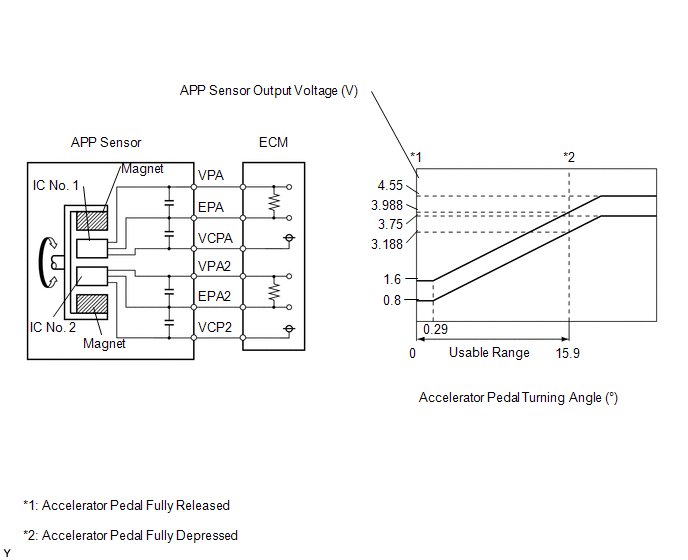 |
DTC No. | DTC Detection Condition |
Trouble Area | | P2120 |
VPA fluctuates rapidly beyond upper and lower malfunction thresholds for 0.5 seconds or more (1 trip detection logic) |
- Accelerator pedal sensor assembly
- ECM
| | P2122 |
VPA 0.4 V or less for 0.5 seconds or more when accelerator pedal fully released (1 trip detection logic) |
- Accelerator pedal sensor assembly
- Open in VCP1 circuit
- Open or ground short in VPA circuit
- ECM
| | P2123 |
VPA 4.8 V or more for 2.0 seconds or more (1 trip detection logic) |
- Accelerator pedal sensor assembly
- Open in EPA circuit
- ECM
| | P2125 |
VPA2 fluctuates rapidly beyond upper and lower malfunction thresholds for 0.5 seconds or more (1 trip detection logic) |
- Accelerator pedal sensor assembly
- ECM
| | P2127 |
VPA2 1.2 V or less for 0.5 seconds or more when accelerator pedal fully released (1 trip detection logic) |
- Accelerator pedal sensor assembly
- Open in VCP2 circuit
- Open or ground short in VPA2 circuit
- ECM
| | P2128 |
Conditions (a) and (b) continue for 2.0 seconds or more (1 trip detection logic):
(a) VPA2 4.8 V or more (b) VPA between 0.4 V and 3.45 V |
- Accelerator pedal sensor assembly
- Open in EPA2 circuit
- ECM
| | P2138 |
Condition (a) or (b) continues for 2.0 seconds or more (1 trip detection logic):
(a) Difference between VPA and VPA2 0.02 V or less (b) VPA 0.4 V or less and VPA2 1.2 V or less |
- Short between VPA and VPA2 circuits
- Accelerator pedal sensor assembly
- ECM
| HINT: When
any of these DTCs are stored, check the accelerator pedal position
sensor voltage by entering the following menus: Powertrain / Engine and
ECT / Data List / Accel Sensor Out No. 1 and Accel Sensor Out No. 2. |
Trouble Area | Accel Sensor Out No. 1
When AP Released | Accel Sensor Out No. 2
When AP Released | Accel Sensor Out No. 1
When AP Depressed | Accel Sensor Out No. 2
When AP Depressed | |
VCP circuit open | 0 to 0.2 V |
0 to 0.2 V | 0 to 0.2 V |
0 to 0.2 V | |
Open or ground short in VPA circuit |
0 to 0.2 V | 1.2 to 2.0 V |
0 to 0.2 V | 3.4 to 4.75 V | |
Open or ground short in VPA2 circuit |
0.5 to 1.1 V | 0 to 0.2 V |
2.6 to 4.5 V | 0 to 0.2 V | |
EPA circuit open | 4.5 to 4.98 V |
4.5 to 4.98 V | 4.5 to 4.98 V |
4.5 to 4.98 V | |
Normal condition | 0.5 to 1.1 V |
1.2 to 2.0 V | 2.6 to 4.5 V |
3.4 to 4.75 V |
HINT:
- Accelerator pedal positions are expressed as voltages.
- AP stands for Accelerator Pedal.
MONITOR DESCRIPTION When
the output voltage of either VPA or VPA2 deviates from the standard
range, or the difference between the output voltages of the 2 sensor
circuits is less than the threshold, the ECM determines that there is a
malfunction in the accelerator pedal position sensor. The ECM then
illuminates the MIL and stores a DTC. Example: When
the output voltage of VPA drops below 0.4 V for more than 0.5 seconds
when the accelerator pedal is fully depressed, DTC P2122 is stored. If the malfunction is not repaired successfully, a DTC is stored 2 seconds after the engine is next started. MONITOR STRATEGY |
Related DTCs | P2120: Accelerator pedal position (APP) sensor 1 range check (fluctuating)
P2122: APP sensor 1 range check (low voltage) P2123: APP sensor 1 range check (high voltage)
P2125: APP sensor 2 range check (fluctuating) P2127: APP sensor 2 range check (low voltage)
P2128: APP sensor 2 range check (high voltage) P2138: APP sensor range check (correlation) | |
Required Sensors/Components (Main) | APP sensor | |
Required Sensors/Components (Related) |
- | | Frequency of Operation |
Continuous | | Duration |
0.5 seconds: P2120, P2122, P2125 and P2127 2.0 seconds: P2123, P2128 and P2138 | |
MIL Operation | Immediate | |
Sequence of Operation | None | TYPICAL ENABLING CONDITIONS |
Monitor runs whenever following DTCs not present |
None | | Either of following conditions 1 or 2 met: |
- | | 1. Ignition switch off to ON |
0.012 seconds or more | | 2. Throttle actuator power |
ON | TYPICAL MALFUNCTION THRESHOLDS P2120 |
Either of the following conditions is met: | 1 or 2 | |
1. All of following conditions met: |
(a) and (b) | | (a) VPA voltage |
0.4 V or less | | (b) VPA2 voltage - Learned VPA2 accelerator off position voltage |
0.04 V or more | | 2. VPA voltage |
4.8 V or more | P2122 |
All of following conditions met: | (a) and (b) | |
(a) VPA voltage | 0.4 V or less | |
(b) VPA2 voltage - Learned VPA2 accelerator off position voltage |
0.04 V or more | P2123 |
VPA voltage | 4.8 V or more | P2125 |
Either of the following conditions is met: |
1 or 2 | | 1. All of following conditions met: |
(a) and (b) | | (a) VPA2 voltage |
1.2 V or less | | (b) VPA voltage - Learned VPA accelerator off position voltage |
0.04 V or more | | 2. VPA2 voltage when VPA voltage 0.4 V or more, and 3.45 V or less |
4.8 V or more | P2127 |
All of following conditions met: | (a) and (b) | |
(a) VPA2 voltage | 1.2 V or less | |
(b) VPA voltage - Learned VPA accelerator off position voltage |
0.04 V or more | P2128 |
VPA2 voltage when VPA voltage 0.4 V or more, and 3.45 V or less |
4.8 V or more | P2138 |
Either of following conditions A or B met: | - | |
Condition A | - | | Difference between VPA and VPA 2 voltages |
0.02 V or less | | Condition B |
- | | VPA voltage | 0.4 V or less | |
VPA2 voltage | 1.2 V or less | COMPONENT OPERATING RANGE |
VPA voltage | 0.4 to 4.8 V | | VPA2 voltage |
1.2 to 4.8 V | | Difference between VPA and VPA2 voltages |
More than 0.02 V | CONFIRMATION DRIVING PATTERN
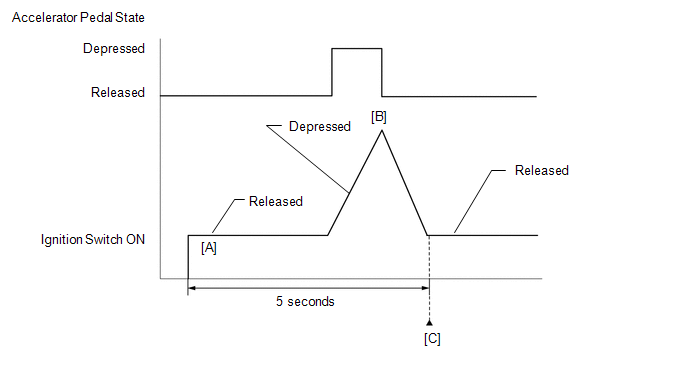
- Connect the Techstream to the DLC3.
- Turn the ignition switch to ON and turn the Techstream on.
- Clear DTCs (even if no DTCs are stored, perform the clear DTC operation).
- Turn the ignition switch off and wait for at least 30 seconds.
- Turn the ignition switch to ON and turn the Techstream on [A].
- Fully depress and release the accelerator pedal [B].
- Check that 5 seconds or more have elapsed since the ignition switch was turned to ON.
- Enter the following menus: Powertrain / Engine and ECT / Trouble Codes [C].
- Read the pending DTCs.
HINT:
- If a pending DTC is output, the system is malfunctioning.
- If a pending DTC is not output, perform the following procedure.
- Enter the following menus: Powertrain / Engine and ECT / Utility / All Readiness.
- Input the DTC: P2120, P2122, P2123, P2125, P2127, P2128 or P2138.
- Check the DTC judgment result.
|
Tester Display |
Description |
|
NORMAL |
- DTC judgment completed
- System normal
|
|
ABNORMAL |
- DTC judgment completed
- System abnormal
|
|
INCOMPLETE |
- DTC judgment not completed
- Perform driving pattern after confirming DTC enabling conditions
|
|
N/A |
- Unable to perform DTC judgment
- Number of DTCs which do not fulfill DTC preconditions has reached ECU memory limit
|
HINT:
- If the judgment result shows ABNORMAL, the system has a malfunction.
- If the judgment result shows INCOMPLETE or N/A, perform steps [B] through [C] again.
- If no pending DTC is output, perform a universal trip and check for permanent DTCs (See page
 ). ).
HINT:
- If a permanent DTC is output, the system is malfunctioning.
- If no permanent DTC is output, the system is normal.
FAIL-SAFE When
DTC P2120, P2121, P2122, P2123, P2125, P2127, P2128 or P2138 is stored,
the ECM enters failsafe mode. If either of the 2 sensor circuits
malfunctions, the ECM limits the engine output. If both of the circuits
malfunction, the ECM regards the accelerator pedal as being released. As
a result, the throttle valve is closed and the engine idles. Fail-safe mode continues until a pass condition is detected, and the ignition switch is turned off. WIRING DIAGRAM
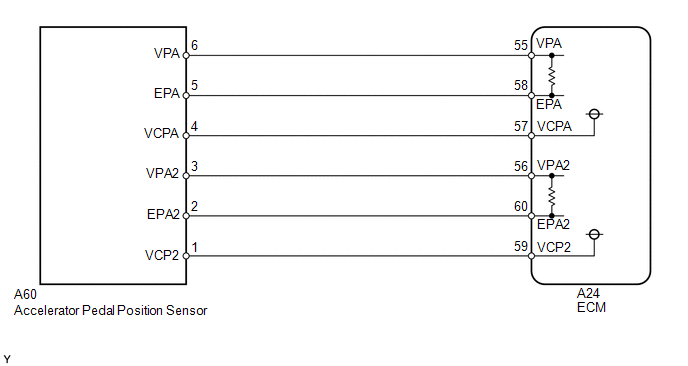 CAUTION / NOTICE / HINT
HINT:
- These DTCs relate to the Accelerator Pedal Position (APP) sensor.
- Read freeze frame data using the Techstream. Freeze frame data records
the engine condition when malfunctions are detected. When
troubleshooting, freeze frame data can help determine if the vehicle was
moving or stationary, if the engine was warmed up or not, if the
air-fuel ratio was lean or rich, and other data from the time the
malfunction occurred.
PROCEDURE |
1. | READ VALUE USING TECHSTREAM (ACCELERATOR PEDAL POSITION SENSOR) |
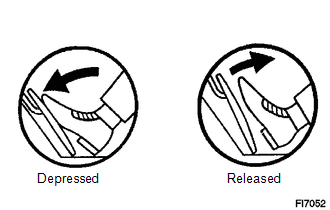 (a) Connect the Techstream to the DLC3.
(b) Turn the ignition switch to ON. (c) Turn the Techstream on.
(d) Enter the following menus: Powertrain / Engine and ECT / Data List / Accel Sensor Out No. 1 and Accel Sensor Out No. 2.
(e) Read the value displayed on the Techstream. Standard Voltage: |
Accelerator Pedal Operation |
Accel Sensor Out No. 1 | Accel Sensor Out No. 2 |
Difference between Accel Sensor Out No. 1 and Accel Sensor Out No. 2 | |
Released | 0.5 to 1.1 V |
1.2 to 2.0 V |
More than 0.02 V | |
Depressed | 2.6 to 4.5 V |
3.4 to 4.75 V | Result |
Result | Proceed to | |
NG | A | |
OK | B |
| B |
 | GO TO STEP 5 |
|
A |
 | |
| 2. |
CHECK HARNESS AND CONNECTOR (ACCELERATOR PEDAL POSITION SENSOR - ECM) |
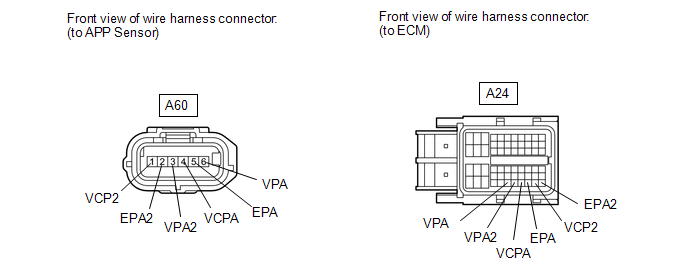 (a) Disconnect the APP sensor connector.
(b) Disconnect the ECM connector. (c) Measure the resistance according to the value(s) in the table below.
Standard Resistance: |
Tester Connection | Condition |
Specified Condition | |
A60-6 (VPA) - A24-55 (VPA) |
Always | Below 1 Ω | |
A60-5 (EPA) - A24-58 (EPA) |
Always | Below 1 Ω | |
A60-4 (VCPA) - A24-57 (VCPA) |
Always | Below 1 Ω | |
A60-3 (VPA2) - A24-56 (VPA2) |
Always | Below 1 Ω | |
A60-2 (EPA2) - A24-60 (EPA2) |
Always | Below 1 Ω | |
A60-1 (VCP2) - A24-59 (VCP2) |
Always | Below 1 Ω | |
A60-6 (VPA) or A24-55 (VPA) - Body ground |
Always | 10 kΩ or higher | |
A60-5 (EPA) or A24-58 (EPA) - Body ground |
Always | 10 kΩ or higher | |
A60-4 (VCPA) or A24-57 (VCPA) - Body ground |
Always | 10 kΩ or higher | |
A60-3 (VPA2) or A24-56 (VPA2) - Body ground |
Always | 10 kΩ or higher | |
A60-2 (EPA2) or A24-60 (EPA2) - Body ground |
Always | 10 kΩ or higher | |
A60-1 (VCP2) or A24-59 (VCP2) - Body ground |
Always | 10 kΩ or higher |
| NG |
 | REPAIR OR REPLACE HARNESS OR CONNECTOR |
|
OK |
 | |
| 3. |
INSPECT ECM (VCPA AND VCP2 VOLTAGE) |
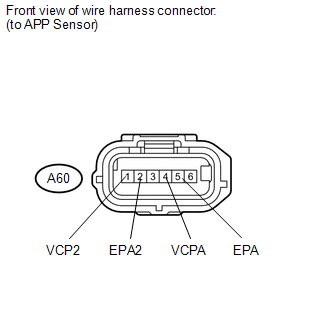 (a) Disconnect the accelerator pedal position (APP) sensor connector.
(b) Turn the ignition switch to ON. (c) Measure the voltage according to the value(s) in the table below.
Standard Voltage: |
Tester Connection | Switch Condition |
Specified Condition | |
A60-4 (VCPA) - A60-5 (EPA) |
Ignition switch ON | 4.5 to 5.5 V | |
A60-1 (VCP2) - A60-2 (EPA2) |
Ignition switch ON | 4.5 to 5.5 V |
| NG |
 | REPLACE ECM |
|
OK |
 | |
| 4. |
REPLACE ACCELERATOR PEDAL SENSOR ASSEMBLY |
(a) Replace the accelerator pedal sensor assembly (See page
 ). ).
|
NEXT |
 | |
| 5. |
CHECK WHETHER DTC OUTPUT RECURS (ACCELERATOR PEDAL POSITION SENSOR DTCS) |
(a) Connect the Techstream to the DLC3. (b) Turn the ignition switch to ON.
(c) Turn the Techstream on. (d) Clear DTCs (See page
 ). ). (e) Drive the vehicle in accordance with the driving pattern described in the Confirmation Driving Pattern.
(f) Read DTCs. Result |
Result | Proceed to | |
P2120, P2122, P2123, P2125, P2127, P2128, and/or P2138 is output |
A | | No DTC is output |
B |
| A |
 | REPLACE ECM |
| B |
 | END | | 




